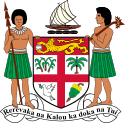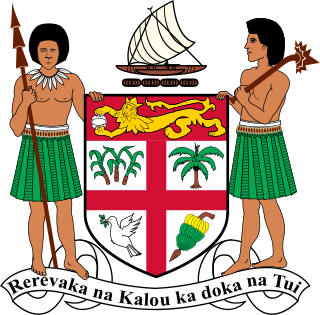 |
|---|
General elections were held in Fiji in June and July 1917. [1]
 |
|---|
General elections were held in Fiji in June and July 1917. [1]
Changes were made to the constitution on 20 July 1916, increasing the number of nominated members in the Legislative Council from 10 to 12; eleven were civil servants and the other had to be a British subject not holding public office. [2] [3] The number of elected Europeans remained at seven and the number of appointed Fijians at two. The Governor served as President of the Council. [1]
The Europeans were elected from six constituencies; Eastern, Northern, Southern, Suva, Vanua Levu & Taveuni and Western. Voting was restricted to men aged 21 or over who had been born to European parents (or a European father and was able to read, speak and write English) who were British subjects and had been continuously resident in Fiji for 12 months, either owning at least £20 of freehold or leasehold property or having an annual income of at least £120, and were not on the public payroll. [2]
| Constituency | Geographical area | Election date |
|---|---|---|
| Eastern | Lau Province, Lomaiviti Province | 22 June |
| Northern | Ba District, Colo North Province, Ra Province | 21 July |
| Southern | Colo East Province, Kadavu Province, Naitasiri Province, Namosi Province, Rewa Province (except Suva), Serua Province, Tailevu Province | 23 June |
| Suva | Suva Municipality | 21 July |
| Vanua Levu and Taveuni | Bua Province, Cakaudrove Province, Macuata Province | |
| Western | Colo West Province, Lautoka District, Nadi District, Nadroga Province | 20 July |
| Constituency | Candidate | Votes | % | Notes |
|---|---|---|---|---|
| Eastern | John Maynard Hedstrom | Unopposed | Re-elected | |
| Northern | Frederick Clapcott | 67 | 69.1 | Elected |
| Henry Lamb Kennedy | 30 | 30.9 | Unseated | |
| Informal votes | 3 | – | ||
| Southern | Robert Crompton | Unopposed | Re-elected | |
| Suva | Henry Marks | 187 | 38.2 | Re-elected |
| Henry Milne Scott | 179 | 36.6 | Re-elected | |
| Francis Reimenschneider | 123 | 25.2 | ||
| Informal votes | 2 | – | ||
| Vanua Levu & Taveuni | Joseph MacKay | 78 | 51.0 | Elected |
| T.A. Montgomery | 70 | 45.8 | ||
| James McConnell | 5 | 3.3 | ||
| Informal votes | 3 | – | ||
| Western | Reginald Harricks | 66 | 71.0 | Elected |
| Charles Wimbledon Thomas | 27 | 29.0 | Unseated | |
| Informal votes | 1 | – | ||
| Source: Ali | ||||
The nominated members were appointed on 3 August. [1]
| Position | Member |
|---|---|
| Governor (President) | Ernest Bickham Sweet-Escott |
| Agent-General of Immigration | Robert Malcolm Booth |
| Attorney General | Alfred Karney Young |
| Chief Medical Officer | George Lynch |
| Colonial Postmaster | Herbert Paul St. Julian |
| Colonial Secretary | Eyre Hutson |
| Commissioner of Lands | Dyson Blair |
| Commissioner of Works | William Akerman Miller |
| Receiver General | Richard Sims Donkin Rankine |
| Registrar-General | Roger Green |
| Secretary for Native Affairs | Kenneth Allardyce |
| Superintendent of Agriculture | Charles Henry Knowles |
| Representing Indo-Fijians | Badri Maharaj |
| Fijian member | Joni Madraiwiwi I |
| Fijian member | Joni Antonio Rabici |
| Source: Fiji Blue Book [1] | |
The results of the Vanua Levu and Taveuni seat were later annulled by the Supreme Court. As a result, a by-election was held in November 1917 which Joseph MacKay was again elected, [4] receiving 84 votes to the 50 of J. Harper received 50 votes and three for James McConnell. [5] However, MacKay died on 6 December. [4] John Francis Dyer was subsequently elected in the constituency in another by-election in 1919. [6]

Since becoming independent of the United Kingdom in 1970, Fiji has had four constitutions, and the voting system has changed accordingly.

Vanua Levu, formerly known as Sandalwood Island, is the second largest island of Fiji. Located 64 kilometres to the north of the larger Viti Levu, the island has an area of 5,587.1 square kilometres (2,157.2 sq mi) and a population of 135,961 as of 2007.

Taveuni is the third-largest island in Fiji, after Viti Levu and Vanua Levu, with a total land area of 434 square kilometres. The cigar-shaped island, a massive shield volcano which rises from the floor of the Pacific Ocean, is situated 6.5 kilometres to the east of Vanua Levu, across the Somosomo Strait. It belongs to the Vanua Levu Group of islands and is part of Fiji's Cakaudrove Province within the Northern Division.

Cakaudrove East Fijian Provincial Communal is a former electoral division of Fiji, one of 23 communal constituencies reserved for indigenous Fijians. Established by the 1997 Constitution, it came into being in 1999 and was used for the parliamentary elections of 1999, 2001, and 2006.. The electorate covered eastern areas of Cakaudrove Province; it included south-eastern Vanua Levu and the nearby islands of Taveuni, Rabi, and Kioa.
James Ranchandar Rao was one of the three Indo-Fijians elected to the Legislative Council of Fiji in October 1929 when Indo-Fijians were given the first opportunity to elect their own representatives in the 1929 elections. The other two were Vishnu Deo and Parmanand Singh.

James Madhavan was an Indo-Fijian politician. He was a member of the Legislative Council and House of Representatives for most of the period between 1947 and 1973 and had two spells in the Executive Council.
The number of Fiji Indians that could be elected to the Legislative Council was fixed over the years as follows:

General elections were held in Fiji on 22 March and 8 April 1905.

General elections were held in Fiji on 23 March and 10 April 1908.

General elections were held in Fiji between 19 May and 20 June 1914.

General elections were held in Fiji in July, August and September 1920.

General elections were held in Fiji in 1923.

General elections were held in Fiji in 1926.

General elections were held in Fiji in 1929. They were the first in which Indo-Fijians were allowed to vote.

General elections were held in Fiji on 31 August 1932, although only one of the nine elected seats was contested.

General elections were held in Fiji in July 1937, the first in which an equal number of Europeans and Indo-Fijians were elected.

General elections were held in Fiji in August 1956; voting took place in the Eastern constituencies between 11 and 18 August, and on 18 August in all other constituencies.

Abortive elections to a Corporation of European settlers were held in Fiji in 1870.
Major William Edmund Willoughby-Tottenham was British army major and later a politician in Fiji, where he served as a member of the Legislative Council in two spells between 1922 and 1937.
Herbert Valentine Tarte (1876–1936) was a Fijian planter and politician. He served in the Legislative Council in the early 1920s.